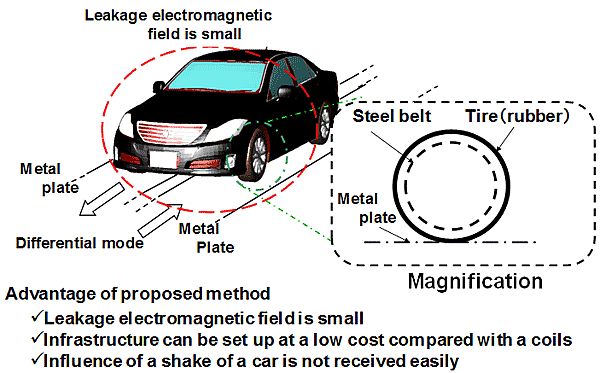
You would be aware of a range of options available for running electrically powered vehicles, also commonly known as EVs. But, here’s an innovative concept taken up by Masahiro Hanazawa of Toyota Central R&D Labs, and by Takashi Ohira of Toyohashi University of Technology – A class-apart, environmentally friendly proposal to power EVs to run unlimited distances! These researchers have taken inspiration from the concept of electric railway system that involves the running train’s cars being powered by an overhead wire. In a similar manner, they have developed a novel idea of a powering a running automobile while on the road, and also away from dangerous obstructions in its way.
High-speed inverters are used to up-convert the energy source from lines of power into radio frequency (RF). These inverters are implanted along road tracks. The RF voltage is then applied to under-the-road, balanced, embedded metal tracks. The RF voltage reaches an EV through electrical capacitance, which is developed between the metal and a steel belt that is installed inside an EV’s tires. Such a concept has the super-ability to take over regular battery-run EVs that have limited continuous running distance in single-time charge. Also, a long battery recharge time, high battery expenses, and the on-board load created due to larger battery loading, are reasons enough for the above innovative idea to create a good hope for the future EV market.
Masahiro and Takashi’s concept not only provides an alternative for combustion engine-based vehicles, but also presents a green approach that could offer a high level of energy efficiency and no gas exhaust, along with the power regeneration possibility from kinetic energy while a vehicle runs slower. The green idea reduces vehicle noise too, and additionally, electric motors may operate on low temperature. In addition to all this, researchers have also conducted some feasibility studies to check the applicability of their concept. They explored this through their experiments where they put metal plates inside a tire and on the floor, and then another plate was positioned above the tire. Electrical impedance, measured between the two plates, indicated that impedance depends on RF frequency in a linear manner and displays 2000-j700 ohm at 1 MHz. To match this, researchers thus designed and implemented a reactance circuit of 50 ohm that is the RF transmission lines’ standard impedance. This whole setup provided a high transmission efficiency with sub 1dB loss.
Thus, even such low-power experiments indicated that energy transfer is feasible from the road to a running vehicle. Then imagine if there would be a high energy transfer on expressways! All your battery problems would go away, as soon as you travel from your place to the nearest interchange, and you cruise on and on the expressway using such a feeder system!




